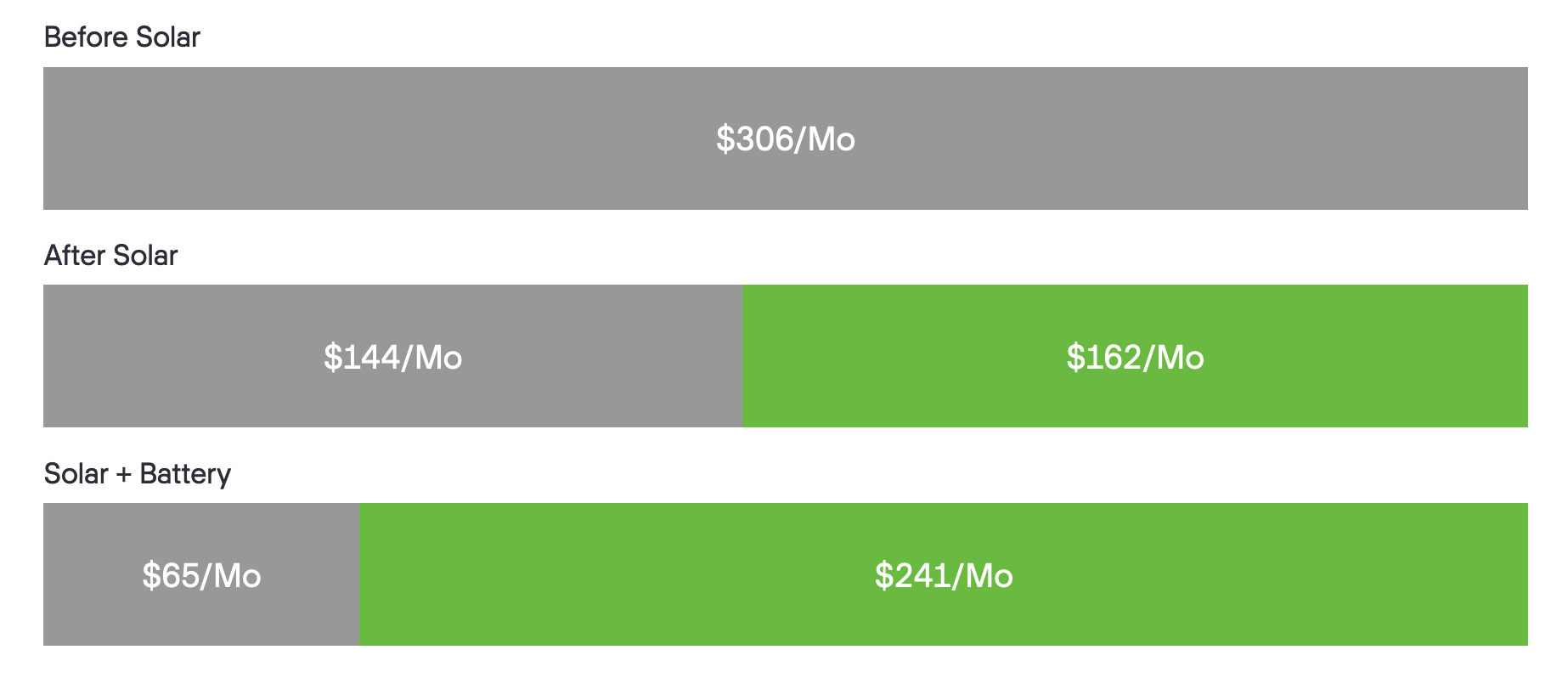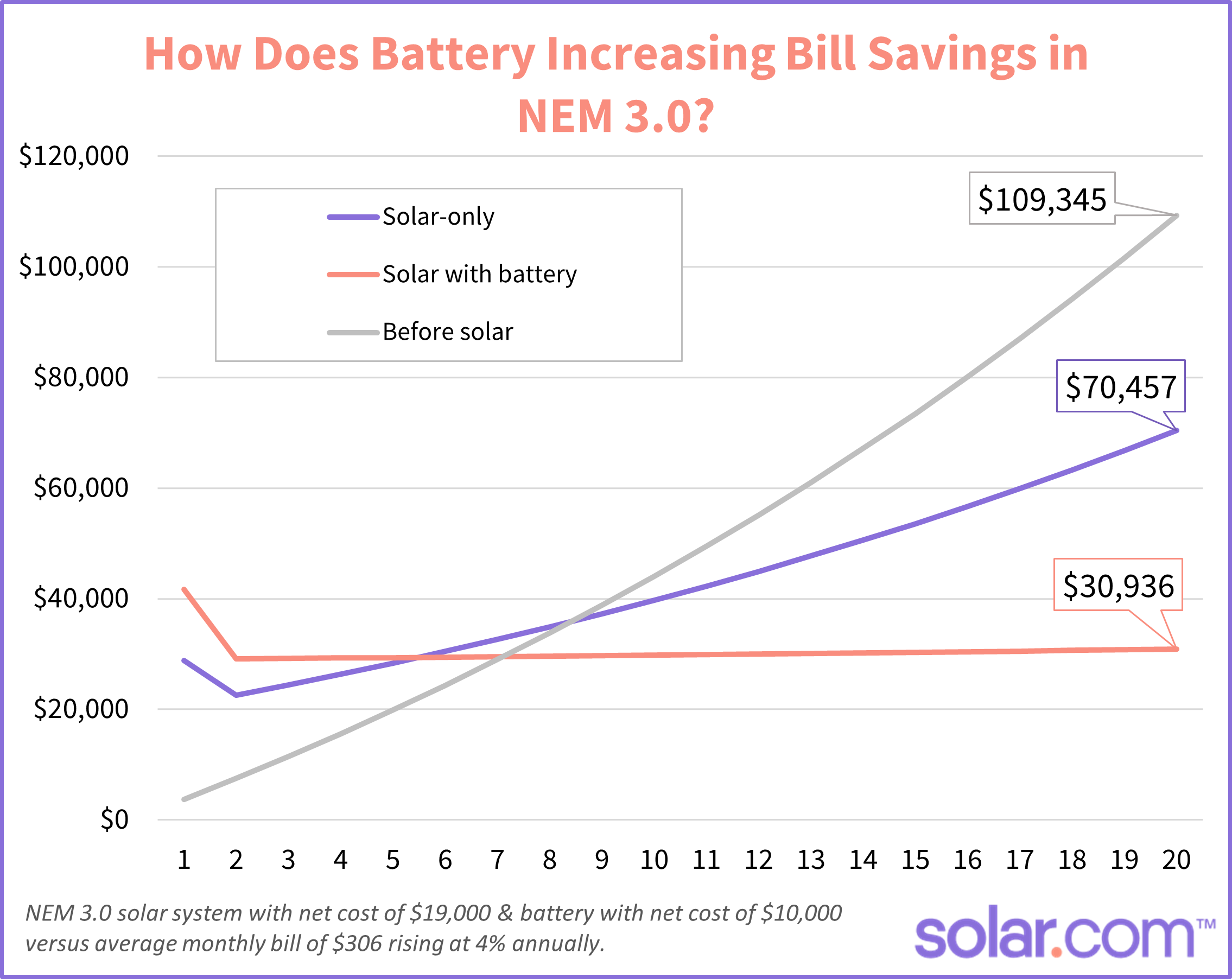Why Is My Electric Bill So High With Solar Panels?
There are two reasons why your electric bill could be high with solar panels.
First, your panels may not be producing enough electricity during the day to power your home and offset the grid electricity you are using at night. This is typically the case for systems with 1:1 net metering.
Second, the value of the excess electricity you are pushing onto the grid during the day is lower than the value of the electricity you pull off the grid at night. This is especially common under California’s NEM 3.0 solar billing policy.
In this article, we’ll explore what causes solar owners to have leftover electricity bills and how to minimize these or prevent them altogether.
Why is my electric bill so high with solar panels and 1:1 net metering?
If your solar system has 1:1 net metering and you still have an amount due on your electricity bill (aside from fixed basic charges), it means that your system isn’t producing as much power as you’re consuming.
Under 1:1 net metering, the value of excess solar electricity is equal to the retail value of grid electricity. So, a system sized to produce 100% of your average consumption should completely offset your electricity bill (aside from certain fixed charges).
There are several reasons why you could have a high electricity bill under 1:1 net metering.
Increased consumption
You’re using more electricity than your panels can offset. This may be due to a heat wave that caused you to run the AC more than usual or a new electric vehicle that you’re charging at home.
Related reading: What Uses the Most Electricity in a Home?
Production loss
If your consumption hasn’t changed significantly, it could be that your panels are underproducing. This could be because of soiling loss (aka dirty panels) or an equipment failure. Check each panel’s performance on your monitoring software and call your installer if there is an issue.
Solar production loss can also stem from natural events like wildfire smoke, heatwaves, and abnormally old cloudy weather.
Your system is too small
If you have a new system that’s not offsetting 100% of your annual consumption, it could be that your system is undersized and simply unable to reduce your electricity bill down to zero.
Related reading: How Many Solar Panels Do I Need To Power a House?
Poor timing
Net metering cycles, in many places, run from March to February. The idea is to build credits through spring and summer to offset lower production in fall and winter. If your system was installed in the fall, it likely won’t produce enough to offset your electricity bill and you won’t have any net metering credits built up yet.
So, you’ll have a few months of leftover electricity bills before your system starts building credit in the spring.
Related reading: When Is The Best Time to Buy Solar Panels?
Why is my electricity bill so high with solar panels under NEM 3.0 solar billing?
California’s NEM 3.0 solar billing is an entirely different animal than 1:1 net metering.
For customers of SCE, PG&E, and SDG&E, the NEM 3.0 solar billing rates do not give as much value to the surplus solar you send to the grid as what you’re charged to draw power from the grid in the evening.
In fact, there are 576 different rates that vary every hour of the day and every month of the year, but the overall average for the value of your surplus power is about 25% of the full retail rate that you’re billed in the evening.
Now, the solar power used directly in your home to power lights, A/C, etc. still has full value since it’s replacing electricity you would have bought from your utility during the day, but the excess power you push onto the grid is only worth around 25% of the power your are buying from the grid when the sun goes down and your solar panels aren’t producing.
As such, you’ll likely have remaining charges for your overnight usage since you’re only offsetting about 25% of those evening costs.
Under NEM 3.0 billing, we typically see monthly electricity bill reductions averaging around 50%, even when the total system production matches the total energy demand from the home over the course of the year, as shown below.

Example average electricity bill before and after solar. The $144 after solar represents the “leftover bill” due to low export rates in NEM 3.0 solar billing.
Even 50% bill savings can be quite substantial, especially as utility rates increase over time. However, it’s not the 100% bill offset that Californians have come to expect from rooftop solar.
How to reduce leftover bills under NEM 3.0
There are a couple of approaches that can address leftover bill amounts due to the lower export rates of NEM 3.0 solar billing. In general, the idea is to store and use as much of your solar production as possible to avoid selling it to the grid at low value.
The best option is pairing the solar system with a battery. You can use a battery to store the surplus energy from the solar system rather than feeding it back into the electric grid, and then use that stored power in the evening rather than drawing in from the grid.
So, let’s say you produce 10 kWh of excess solar power during the day. Instead of selling it to the grid for 7.5 cents per kWh, you can store it in a battery and use it at night to avoid buying utility electricity at 30 cents per kWh.
The idea is to squeeze the most value out of every kWh of solar production. In the example below, adding a battery reduces the electric bill by $79 per month or nearly $950 per year.

Using battery storage can reduce the leftover monthly bill by 50% or more and, in many cases, bring it down to minimum basic charges.
As utility rates increase over time, reducing that leftover electricity bill adds up to serious savings. The graph below shows the cumulative cost of before solar, after solar, and solar + battery over 20 years.

- Without solar, a $306 monthly utility bill adds up to nearly $110,000 over 20 years, assuming 4% rate increases each year
- With solar only, reducing the bill by ~50% adds up to nearly $40,000 in electricity cost savings over 20 years
- With solar and battery, reducing the bill by ~80% adds up to nearly $80,000 in energy costs savings over 20 years.
Yes, you’ll likely need to replace the battery at some point – but at most that puts a $10,000 dent in your $80,000 savings. And in 10-15 years, home batteries will likely cost a few thousand dollars.
The bottom line
There are many things that could cause a high electricity bill with solar panels. If you have 1:1 net metering and your system is designed to produce 100% of your electricity usage, it’s important to diagnose the issue quickly in order to prevent further lost savings.
Under NEM 3.0 billing in California, substantial leftover bill amounts are to be expected for solar-only systems. However, adding battery storage to the system can significantly reduce your interaction with the grid and, by extension, your leftover bill amounts.








